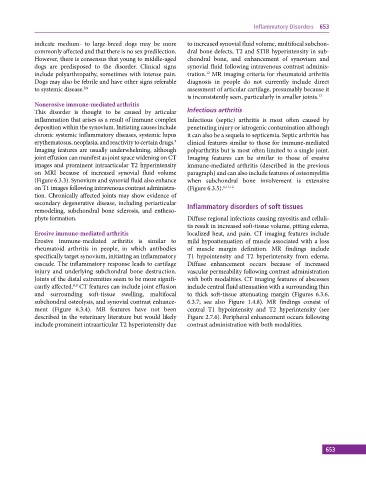Page 663 - Atlas of Small Animal CT and MRI
P. 663
Inflammatory Disorders 653
indicate medium‐ to large‐breed dogs may be more to increased synovial fluid volume, multifocal subchon-
commonly affected and that there is no sex predilection. dral bone defects, T2 and STIR hyperintensity in sub-
However, there is consensus that young to middle‐aged chondral bone, and enhancement of synovium and
dogs are predisposed to the disorder. Clinical signs synovial fluid following intravenous contrast adminis-
include polyarthropathy, sometimes with intense pain. tration. MR imaging criteria for rheumatoid arthritis
12
Dogs may also be febrile and have other signs referable diagnosis in people do not currently include direct
to systemic disease. 8,9 assessment of articular cartilage, presumably because it
is inconsistently seen, particularly in smaller joints. 13
Nonerosive immune‐mediated arthritis
This disorder is thought to be caused by articular Infectious arthritis
inflammation that arises as a result of immune complex Infectious (septic) arthritis is most often caused by
deposition within the synovium. Initiating causes include penetrating injury or iatrogenic contamination although
chronic systemic inflammatory diseases, systemic lupus it can also be a sequela to septicemia. Septic arthritis has
8
erythematosus, neoplasia, and reactivity to certain drugs. clinical features similar to those for immune‐mediated
Imaging features are usually underwhelming, although polyarthritis but is most often limited to a single joint.
joint effusion can manifest as joint space widening on CT Imaging features can be similar to those of erosive
images and prominent intraarticular T2 hyperintensity immune‐mediated arthritis (described in the previous
on MRI because of increased synovial fluid volume paragraph) and can also include features of osteomyelitis
(Figure 6.3.3). Synovium and synovial fluid also enhance when subchondral bone involvement is extensive
on T1 images following intravenous contrast administra- (Figure 6.3.5). 6,11,12
tion. Chronically affected joints may show evidence of
secondary degenerative disease, including periarticular Inflammatory disorders of soft tissues
remodeling, subchondral bone sclerosis, and entheso-
phyte formation. Diffuse regional infections causing myositis and celluli-
tis result in increased soft‐tissue volume, pitting edema,
Erosive immune‐mediated arthritis localized heat, and pain. CT imaging features include
Erosive immune‐mediated arthritis is similar to mild hypoattenuation of muscle associated with a loss
rheumatoid arthritis in people, in which antibodies of muscle margin definition. MR findings include
specifically target synovium, initiating an inflammatory T1 hypointensity and T2 hyperintensity from edema.
cascade. The inflammatory response leads to cartilage Diffuse enhancement occurs because of increased
injury and underlying subchondral bone destruction. vascular permeability following contrast administration
Joints of the distal extremities seem to be more signifi- with both modalities. CT imaging features of abscesses
cantly affected. CT features can include joint effusion include central fluid attenuation with a surrounding thin
8,9
and surrounding soft-tissue swelling, multifocal to thick soft‐tissue attenuating margin (Figures 6.3.6,
subchondral osteolysis, and synovial contrast enhance- 6.3.7; see also Figure 1.4.8). MR findings consist of
ment (Figure 6.3.4). MR features have not been central T1 hypointensity and T2 hyperintensity (see
described in the veterinary literature but would likely Figure 2.7.6). Peripheral enhancement occurs following
include prominent intraarticular T2 hyperintensity due contrast administration with both modalities.
653

